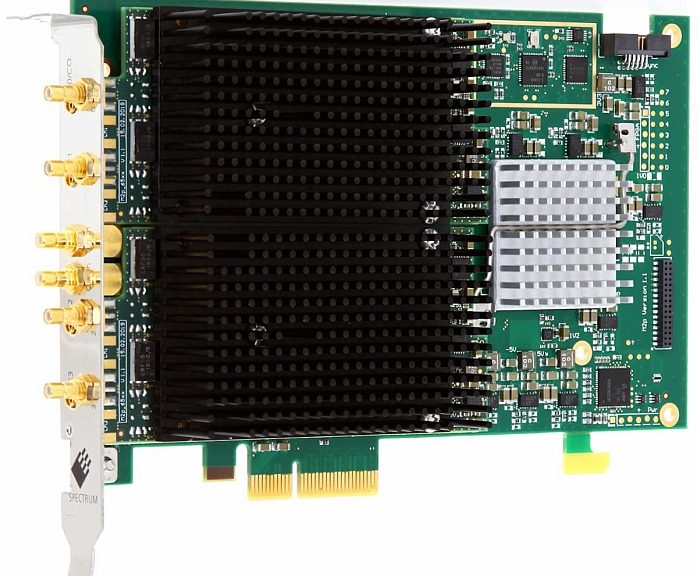- Spectrum Instrumentation has added six new Arbitrary Waveform Generators (AWGs) to its recently released M2p.65 xx series of PCIe cards.
- The new AWGs extend the product family’s capabilities by boosting the available output range, so that waveforms can be generated in the DC to 60 MHz range with amplitude swings of up to ±12 V into 1 MOhms or ±6 V into 50 Ohms.
- To achieve the higher output voltage ranges, the cards have been fitted with additional amplification and larger cooling plates.
- This makes the cards a little wider, so that they occupy two PCIe slots, but they are still just 168 mm in length.
The M2p.65xx series AWGs use the latest 16-bit Digital-to-Analog Converters and feature a PCIe x4 interface with up to 700 MByte/s streaming speed. Users can select output speed rates of either 40 MS/s (M2p.654x series) or 125 MS/s (M2p.657x series) and models with one, two or four channels per card.
Each channel features its own DAC and output stage. Multi-channel cards share a common clock and trigger to ensure synchronization and the output stages incorporate four switchable filter paths to help optimize signal quality. The flexible output stages combine with the high resolution 16-bit DACs to enable the generation of signals.
To allow the M2p.65xx series AWGs to generate long and complex waveforms, each card comes equipped with a 512 MSamples of on-board memory. The large memory is complemented by different output modes. For example, the memory can be segmented and waveforms can be created by looping on and switching between different segments. The cards also feature a FIFO streaming capability that enables new waveform data to be read over the PCIe bus (at rates of up to 700 MB/s) while replaying already transferred information. This flexibility allows users to create ultra-long, single shot waveforms or constantly changing.
For applications that require the connection of AWGs and Digitizers, such as stimulus-response or closed-loop applications, Spectrum’s Star-Hub piggy-back module synchronizes up to 16 different M2p class products. The new M2p.65xx AWGs match with the M2p.59xx 16-bit digitizers released in 2018. The M2p.59xx digitizers offer one to eight channels with sampling rates between 5 MS/s and 125 MS/s. The Star-Hub distributes a common clock and trigger signal to each channel ensuring synchronous operation. Star-Hub systems are also perfect for situations where multiple test points or arrays of sensors need to be stimulated by different test signals at the same time.
The cards are programmable and drivers are provided, free of charge, to support the most popular languages (such as C++, VB.NET, C#, J#, Delphi, Java or Python code) as well as third party software tools like LabVIEW and MATLAB. Alternatively, users can run Spectrum’s own software, SBench 6 Professional.
SBench 6 enables the user to control all the modes and settings of the AWG via a sofware interface. The software is designed to support multi-channel operation and has built-in features for waveform display, signal generation, data analysis and documentation. Basic signals can be created using the software’s EasyGenerator function that produces waveforms like sine waves, triangles or rectangles with programmable frequency, amplitude and phase. More complex signals can be created using mathematical equations or imported from other programs or devices (such as digitizers or oscilloscopes) using Binary, ASCII, or Wave formats.
The signal outputs as well as clock and trigger inputs are provided via front-panel SMB connectors. The front-panel also hosts four MMCX connectors (one multi-function output, and three multi-function I/O lines), which can be used for different tasks such as digital output channels, clock, trigger or status output as well as asynchronous I/O lines. This connectivity allows the AWG cards to be adapted into most automated test system.
Switching the multi-purpose I/O lines to digital output adds another four synchronous output channels to the AWG. A single AWG card can then generate four analogue outputs and four digital outputs in parallel with full speed.






